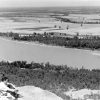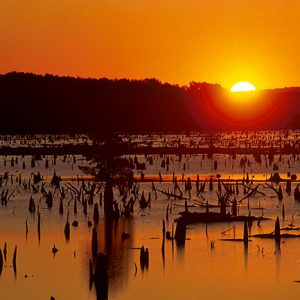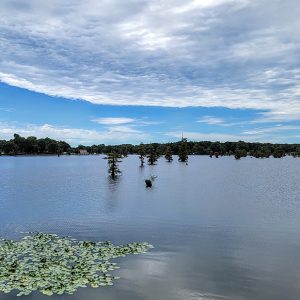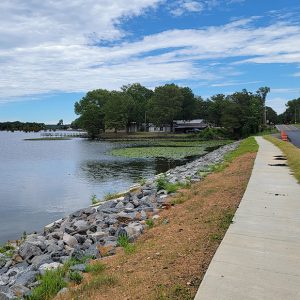calsfoundation@cals.org
Lake Conway
aka: Craig D. Campbell Lake Conway Reservoir
Lake Conway, located three miles south of Conway (Faulkner County) on Interstate 40, is the largest lake ever constructed by a state wildlife agency and the first lake constructed by the Arkansas Game and Fish Commission (AGFC). It is one of the state’s most popular fishing spots due to its size, central location, and large populations of bass, catfish, crappie, bluegill, and redear.
As early as 1900, Conway residents wanted a fishing lake close to town. In 1940, Dr. James H. Flanagin Sr., a local dentist and a member of the Faulkner County chapter of the Arkansas Wildlife Federation (AWF), was asked by William D. Cole, president of the Conway Chamber of Commerce, to research the feasibility of constructing a lake close to town. The area that was chosen for the lake site was six miles of land between Saltillo (Faulkner County) and Mayflower (Faulkner County) along Palarm Creek, a stream that begins a mile north of Vilonia (Faulkner County) and flows southwest into the Arkansas River. The land was cheap because it was swampy and lacked good timber. Even though the land was only worth about fifty cents an acre, the Faulkner County chapter still had to seek out additional funding before purchasing the land and beginning construction.
At first, the Faulkner County chapter sought the help of the U.S. Fish and Wildlife Service, which rejected providing funds for the project because it wanted to construct a migratory bird refuge, not a fishing lake. The Faulkner County chapter then turned to the U.S. Army Corps of Engineers, who agreed to only two of three flood-control steps requested in the AWF’s lake construction plan. The federation then turned to the residents of Faulkner County, who provided $20,000 in voluntary contributions in order to purchase the land at the lake’s proposed site.
However, the publicity resulting from the fundraising campaign caused the landowners around the proposed construction site to raise the price of their land, with prices in some cases going to $100 an acre. Eventually, the Faulkner County chapter had to raise another $45,000 in order to purchase the land, more than double the original price. Eventually, Flanagin, Cole, and William M. Apple, the state-level secretary of the AWF, turned to all Arkansas residents for funding. Under the leadership of Paul Litzke, a door-to-door fundraising campaign raised an additional $45,000 from more than 50,000 contributors statewide. Compensation to individual landowners varied from one dollar to $3,950. There were also many donations.
Thirty-five lawsuits from reluctant landowners and various businesses that had interests in the area—including the Magnolia Pipeline Company, Missouri Pacific Railroad, and the Federal Land Bank of St. Louis—were heard before construction on the lake could begin. These were eventually settled. Another obstacle was waste disposal. Stone Dam Creek had been used to dispose of Conway’s sewage. This sewage would have emptied into Palarm Creek above the dam and subsequently polluted the lake. A modern sewage disposal plant was constructed at Stone Dam, allowing Lake Conway’s construction to go forward.
A few landowners continued to hold out. The AWF sought the help of the AGFC, but the commission did not have the legal authority to take control of the land. A petition campaign to change the Arkansas state constitution, led by Litzke, proved successful. Amendment 35 was passed in 1945, allowing the AGFC to condemn land and acquire it for public use.
Construction began on the 6,700-acre lake in 1950. The R. W. Hammock Construction Company of Van Buren (Crawford County) constructed the concrete spillway and dirt dam about a mile downriver from the original construction site on Palarm Creek after it was determined that it was too deep to reach bedrock at the original location. The final project’s cost varied between $150,000 and $196,000 due to legal fees. The AGFC funded a majority of the construction once the land was purchased, but the commission continued to allow limited timber harvesting by former landowners and businesses during Lake Conway’s early days in order to partially recoup construction costs.
Lake Conway was formally opened and dedicated on July 4, 1951. In 1968, a nursery pond was constructed on the east side of the lake, feeding fish directly into the lake. The lake has an average depth of six feet, with a maximum depth of eighteen feet. Partially submerged stumps, log piles, and cypress trees provide cover for the sport fish, which forage on shad and small sunfish. Migratory birds often seek refuge on the lake and feed on the fish populations that concentrate near the submerged timber. Since the construction of Lake Conway, the AGFC has made it a policy to extend its ownership to land around lakes, as the increased use of the lake in recent years requires more intensive conservation efforts on the part of government agencies.
The Lake Conway Monster is a mythical creature that supposedly haunts the waters of Lake Conway, with the first reported sighting taking place in 1952.
In June 2011, the AGFC officially renamed Lake Conway the Craig D. Campbell Lake Conway Reservoir after outgoing commission chairman Craig D. Campbell. On March 29, 2013, the Pegasus Pipeline transporting diluted bitumen (a.k.a. “dilbit”) through the Mayflower area ruptured, spilling 134,000 gallons into the Northwoods subdivision, some of which reached an inlet of Lake Conway known as Dawson Coe. Lake Conway was one of many Arkansas locations affected by the Flood of 2019, with water flowing backwards into the lake from Palarm Creek.
On June 14, 2023, the AGFC approved a plan to rejuvenate the lake, which had seen the loss of fish habitat over several years from siltration, or the filling of the lake with mud and silt. The plan entails draining the lake to expose the bottom to the air, allowing it to harden, making it less absorbent and thus more capable of retaining water, as well as adding natural and artificial structures for fish. At an estimated cost of $15 million, the plan will be the largest project the AGFC has undertaken.
For additional information:
“Craig D. Campbell Lake Conway Reservoir.” Arkansas Game and Fish Commission. https://www.agfc.com/en/zone-map/fishing-map/579/ (accessed June 15, 2023).
Hendricks, Bryan. “Conway Facelift.” Arkansas Democrat-Gazette, June 16, 2023, pp. 1C, 6C. Online at https://www.arkansasonline.com/news/2023/jun/16/conway-facelift/ (accessed June 16, 2023).
———. “Plan Will Revive Lake Conway.” Arkansas Democrat-Gazette, June 15, 2023, p. 5C. Online at https://www.arkansasonline.com/news/2023/jun/15/plan-will-revive-lake-conway/ (accessed June 15, 2023).
McFadin, Daniel. “Work Progresses at Lake Conway.” Arkansas Democrat-Gazette, November 26, 2023, pp. 1B, 3B. Online at https://www.arkansasonline.com/news/2023/nov/26/treasure-hunters-on-hold-as-work-progresses-on/ (accessed November 27, 2023).
Meriwether, Robert W. “The Construction of Lake Conway.” Faulkner Facts and Fiddlings 36 (Spring/Summer 1994): 9–24.
Poe, Deleta Jacqueline. “Lake Conway: Arkansas’ Newest, Finest Playground.” Arkansas Historical Quarterly 12 (Summer 1953): 106–114.
Taylor, Mary Ruth. “Bake the Lake: Plans to Drain Lake Conway Have Neighbors Heated.” Arkansas Times, August 2023, pp. 22, 24–25. Online at https://arktimes.com/arkansas-blog/2023/06/28/bake-the-lake-plans-to-drain-lake-conway-have-neighbors-heated (accessed June 28, 2023).
Aaron W. Rogers
Conway, Arkansas

 Lake Conway
Lake Conway  Lake Conway
Lake Conway  Lake Conway
Lake Conway 



Comments
No comments on this entry yet.